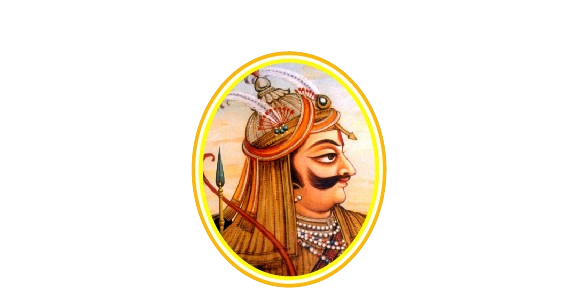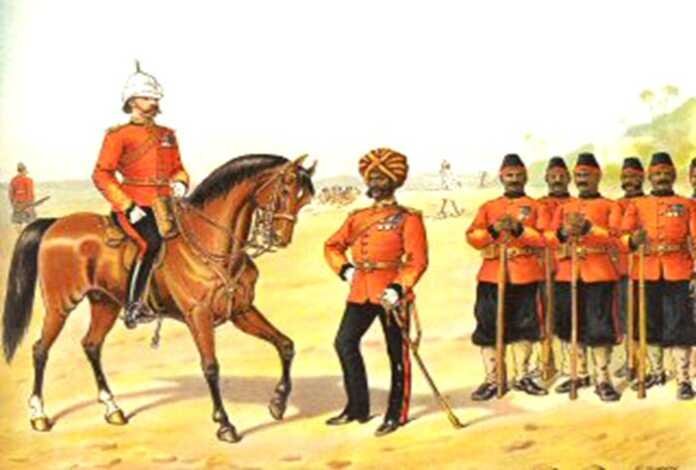British Paramountcy In Rajasthan is a forgotten history now but in British era all princely states were under high Political pressure of British officers.
The Mughals had kept the Rajput princes of Rajputana under strict control, and were not allowed to indulge in mutual warfare. But with the fall of the Mughal Empire their century-old hidden, clannish rivalry and jealousy suddenly arose and swept over the whole of Rajasthan.
The utter weakness of some of the chiefs and the general disorder following the disappearance of a paramount authority opened Rajputana to the ambitious Marathas, and by 1803 all Rajputana, except the remote States in the north and north-west, had been virtually brought under subjection by the Marathas, who exacted tribute, annexed territory and extorted subsidies.
Lord Wellesley crippled Sindhia’s power in the east and north-east, and the British Government made a treaty of alliance with Bharatpur and Alwar in 1803 against the Marathas.[1]
After Lord Wellesley’s departure from India the Maratha peus Pathan leaders got a temporary opportunity. Marquis of Hastings came with his plan to put down lawless banditti and to accord each recognised on condition of State, British protection and territorial guarantee, acknowledging British right of arbitration and general supremacy in external disputes and political relations.[2]
In 1817 the BritishArmies took the field against the Pindaris and by crushing Amir Khan rescued Rajputana from the Pindari menace. By another treaty with Daulat Rao Sindhia, signed on 25th June 1818, the British Government obtained the district of Ajmer. Treaties were concluded with Karauli and Kotah in 1817, and by the end of 1818, all the other states of Rajputana (excepting Sirohi) came under British protection. The East India Company, now became the common controlling authority amongst Rajput states.
After establishing its way over Rajputana, the British Government put an end to the independent plundering Mers in Merwara. Jhak and Chaug, two important Mer villages were levelled to the ground and strong police posts were stationed in MerArea.[3] But in November 1820, the British had to face a general insurrection. This could be crushed only after three months struggle. Then came the turn of Bhils of Udaipur, Dungarpur and Banswara.
They were incited to rebellion by some of the disaffected nobles of these states. In 1825 the Bhil chiefs were compelled to make terms. During 1840-44 the Mewar Bhil corps was raised with the object of checking their predatory habits. In the case of Jodhpur State, the district of Mallani was for centuries one continual scene of anarchy and confusion.
The Jodhpur Darbar expressed its inability to control and the British Government occupied it in 1836 and restored order by reducing the principal Thakurs.
In short, Rajputana was freed from the Marathas and the Pindaris, plundering Mers and Bhils. The British protectorate over Rajasthan re-established peace and political unity under a common supervisory authority.
The Rajput states thus were transformed from Independent status to that of states in subordinate alliance with no international relations, i. e., from political and international equality to subordination and dependence.
How did this catastrophic change in the position of the Rajput states came about? They, caught between the upper stone of Maratha domination and the nether stone of Pathan depredations, preferred British tutelage to cherishing their “full sovereignty” in isolation.[4]
The Rajputs who had defied the Muslims for centuries voluntarily surrendered to the British. Even Udaipur accepted the position of ‘subordinate Alliance.
Lord Hastings asked the Rajput states to accept the obligation of ‘acting in subordinate co-operation with the British Government and acknowledging its supremacy.’ [5] Under this system, their political intercourse with one another was controlled and they were required to submit their disputes to the arbitration and decision of the paramount power. Their armies were severely curtailed and the resources of their states were placed at the disposal of the British Government whenever called upon to do so. The princes thus lost independence by accepting British protection.
Lord Canning, upon whom devolved the responsibility of pacifying the Post-Mutiny India, hastened to assure the Princes that the British Government no longer coveted their territories. He accordingly granted adoption sanads to a number of them. The Rajput princes welcomed these sanads as a godsend, although this boon completely destroyed their pretensions to independence.
The British Government, by incurring the responsibility of protecting the States against rebellion and insurrection, assumed paramountcy over them. The Princes, very soon sank into great depths of degradation since they had no incentive to work hard. The result was mismanagement of their administration as they left it to their Dewans and Karbharies.
The greater the apathy on their part the more minute and irritating became the interference of the British Political Officers. Because, it was not in its own interests that misrule in the States should flare up into a conflagration leaping across to British Indian borders. It, therefore, stepped in whenever it feared the development of such a situation. Udaipur, Jaipur and Jodhpur are ample testimony of their unregulated intervention.
In Bharatpur case, in 1825, a serious disturbance over the succession to the thrown of Bharatpur caused great excitement, not locally, but in the surrounding states, some of them even secretly taking sides in the quarrel which threatened to spread into war. Accordingly, with the object of preserving the public peace, the British Government determined to displace the usurper and maintain the rightful chief; and Bharatpur was stormed and taken by British troops on January 18, 1826.[6]
Similarly, in 1825, Maharawal Jaswant Singh II of Dungarpur was deposed for his incompetency and the disturbances of the peace which he created, and his adopted son, Dalpat Singh, grandson of Sawant Singh, Chief of Pratapgarh, was made regent.
In 1839, the government of Jodhpur under Man Singh, the ascendancy of the Naths, and the consequent disaffection and insurrection persuaded the British Government to interfere. A force was marched to Jodhpur, which it held under military occupation for five months, when Man Singh executed an engagement to ensure future good Government.
The Post-Mutiny change brought no improvement in the status of the Rajput princes. On the contrary, intervention for the prevention of of flagrant misrule was now asserted as a matter of right.”[7]
In his great darbar in Rajputana, Lord Mayo said to the Princes, “If we respect your rights and privileges…… we expect in return good Government”.
In Tonk, Muhammad Ali Khan was deposed by the British Government in November, 1867 as a punishment for his complicity in an attack on the uncle and followers of his tributary the Thakur of Lawa.
The Maharawal of Banswara twice incurred the displeasure of the British in 1866 and 1873.[8] In short, the Brittsh Government and it’s political officers deemed it their right to interfere in the States’ administration in the minutest detail.
The British Government while supporting the authority of the Princes, was also espousing the acknowledged rights and privileges of the Thakurs and thus tried to maintain its control over them. By this device, the bonds of their dependence were further tightened.
The Rajput princes were allowed a free h and over their feudatories, bordering sometimes on oppression. The subjugation of the feudal nobles presented a real problem in m any of the Rajputana States.
In the case of Jodhpur, for instance, after the singing of the Treaty of subordinate co-operation, Man Singh either put to death or imprisoned most of the nobles who, during his assumed imbecility, had shown unfriendly feelings towards him. The British Government found an opportunity to interfere and in 1824 the Maharaja agreed to restore the estates confiscated by him to certain chiefs, in order to please the British Government.[9]
Other chiefs who were not admitted to favour, organized a rebellion against the Maharaja, using Jaipur as a base of hostile operations, not without the support of that state, which had been unable to resist the temptation of causing trouble to its ancient foe. The ruler of Jodhpur demanded assistance of the Paramount Power, but the British Government politely declined.
The Maharawal of Banswara twice incurred the severe displeasure of the Viceroy in 1866 and in 1873. On the former occasion, he trumped up a false charge against his feudatory Chief of Khusalgarh, for which he was fined and punished by a temporary reduction of his Salute. On the latter occasion, he attacked a border village belonging to Partapgarh, and was again punished by the continued withdrawal of his full Salute.
When, in 1870, civil war was expected inAlwar between the Maharao and His Highness’ Thakurs, the Maharao was called upon to submit in writing his acceptance of arbitration, and his undertaking to abide by the result without any condition or reservation.
By assuming paramountcy over the States the British Government incurred the responsibility of ensuring ordered government in these states. Therefore, the feudal and military organization of the Rajput States gave place to the modern conception of centralized administration, to the civil government whose sphere of activity extended to the entire life of the people to the State, as an organism with definite functions and obligation.
REFERENCES
[1] Imperial Gazetteer of India, Vol. XXI, p. 99.
[2] Imperial Gazetteer of India, Vol. XXI, p. 101.
[3] Rajputana Gazetteer, Vol. I-A.
[4] V.B. Kulkarni, The Future of Indain States, p. 46.
[5] K.R.R. Sastry: Indian States, p. 19. e.g., Article III, Treaty with Udaipur dated 13.1.1818; Art. III, Treaty with Jodhpur, dt. 6.1.1818; Art. III, Treaty with Bikaner, dt. 9.3.1818.
[6] Rajputana Gazetteer, Vol. II-A.
[7] V.B. Kulkarni, The Future of Indian States, p, 15.
[8] Lee, Warner: Protected Princes of India, p. 266.
[9] Lee Warner, Protected Princes of India, p. 265.




